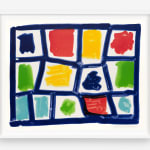Stanley Whitney
Whitney’s handling of color in ‘Pace Be Still’ is both a celebration of pigment and a study in relational dynamics. The colors are luminous, their application showing an intuitive grasp of their visual weight and vibrational quality. His palette is not confined to the spectral constraints but rather draws from a sophisticated range that hints at both the natural world and the urban environment. The gestural texture within each color field adds a layer of depth and complexity, reminding the viewer of the artist's hand and the physicality of the painting process. This gestural quality imbues the lithograph with a vitality that belies its flat surface, as Whitney uses texture to add a tactile dimension to his abstract vocabulary.
Within the oeuvre of Stanley Whitney, ‘Pace Be Still’ emerges as a vibrant articulation of his contributions to the evolution of abstraction in contemporary art. Whitney distills his acute observations of color theory and compositional geometry to bolster a distinct and potent visual language that dialogues with the legacies of Color Field painting and lyrical abstraction. His work is a testament to the power of color as a means of communication, a vehicle for emotional and intellectual inquiry, and a foundation for a broader discourse on abstraction. Whitney's unique approach to the grid, with its inherent suggestion of both order and infinity, allows him to transcend the pictorial field and engage with the endless possibilities of abstraction. In doing so, he reaffirms the genre’s relevance and underscores its capacity for continuous reinvention.
NOTES
This artwork is numbered, signed, and dated in pencil on the lower margin, from the edition of 125.
Provenance
Private collection, United StatesPrivate collection, acquired from the above




